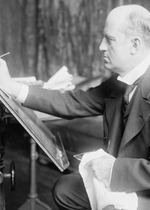 Charles Dana Gibson (September 14, 1867 - December 23, 1944) was an American illustrator who created the Gibson Girl, an iconic representation of the beautiful and independent American woman at the turn of the 20th century.
Charles Dana Gibson (September 14, 1867 - December 23, 1944) was an American illustrator who created the Gibson Girl, an iconic representation of the beautiful and independent American woman at the turn of the 20th century.He published his illustrations in Life magazine and other major national publications for more than 30 years, becoming editor in 1918 and later owner of the general interest magazine.
A talented youth with an early interest in art, Gibson was enrolled by his parents in New York City's Art Students League, where he studied for two years.
Peddling his pen-and-ink sketches, Gibson sold his first work in 1886 to Life magazine, founded by John Ames Mitchell and Andrew Miller. It featured general interest articles, humor, illustrations, and cartoons. His works appeared weekly in the popular national magazine for more than 30 years. He quickly built a wider reputation, with his drawings being featured in all the major New York publications, including Harper's Weekly, Scribners and Collier's. His illustrated books include the 1898 editions of Anthony Hope's The Prisoner of Zenda and its sequel Rupert of Hentzau as well as Richard Harding Davis' Gallegher and Other Stories.
It is an oft-repeated urban legend that Gibson's wife and her elegant Langhorne sisters inspired his famous Gibson Girls, who became iconic images in early 20th-century society. The truth is that the first Gibson Girl appeared in 1890, more than two years before Gibson ever met the Langhorne family, and in later years it became fashionable for many of Gibson's friends and family to model for his illustrations.
After the death of John Ames Mitchell in 1918, Gibson became editor of Life and later took over as owner of the magazine. As the popularity of the Gibson Girl faded after World War I, Gibson took to working in oils for his own pleasure. In 1918, he was elected into the National Academy of Design as an Associate member, and became a full Academician in 1932.
He retired in 1936, the same year Scribner's published his biography, Portrait of an Era as Drawn by C. D. Gibson: A Biography by Fairfax Downey. At the time of his death in 1944, he was considered "the most celebrated pen-and-ink artist of his time as well as a painter applauded by the critics of his later work." (source: wikipedia)
You are WELCOME to enjoy our site & read ALL our books online. But to download & join our forum please create a FREE account or
login

